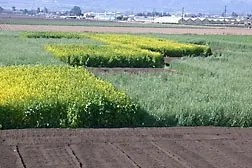
Brennan's results indicated that all three cover crops yielded more dry matter than the two tons of crop residue per acre often recommended for maintaining soil organic matter. The legume-rye and rye cover crops produced approximately 25 percent more dry matter biomass than the mustard crops. But effectively suppressing weeds with the legume-rye crops required seeding at three times the typical rate, while rye and mustard crops appeared to suppress weeds adequately with typical seeding rates.
The long-term study also provided Brennan with more data about year-to-year yield variations in the legume-rye mix, including why legumes, which make up most of the seed costs, are not consistently abundant. Brennan thinks cooler early-season weather helps legumes compete with the rye. So when a hot and dry autumn is expected, producers might want to use a rye cover crop and skip spending the money on a cover crop with legumes.
Brennan, who works at the ARS Crop Improvement and Protection Research Unit in Salinas, has published some his findings in Agronomy Journal and Applied Soil Ecology.
Read more about this research in the February 2013 issue of Agricultural Research magazine.
